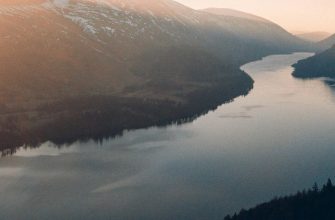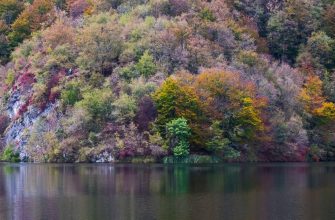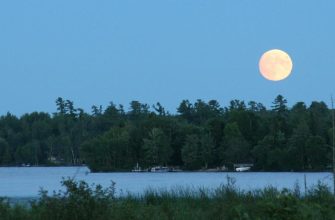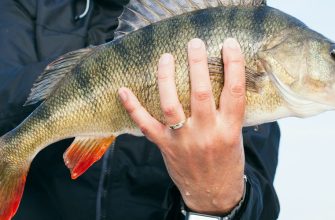- About Lake Perris in Southern California
- Overview of Lake Perris
- Lake Perris Lake Map
- Perris Lake Amenities
- Directions to Lake Perris
- Perris Lake Hours & Fees
- Important Lake Warnings
- Nearby Fishing Lakes
- What type of fish can be found in Lake Perris?
- Largemouth Bass
- Spotted Bass
- Rainbow Trout
- Bluegill
- Catfish
- Perch
- Bass Fishing at Lake Perris
- Types of Bass at Lake Perris
- Largemouth Bass
- Spotted Bass
- Best Techniques for Bass Fishing
- 1. Use the Right Gear
- 2. Master the Art of Casting
- 3. Experiment with Different Retrieval Techniques
- 4. Target Early Morning and Late Evening
- Top Spots for Bass Fishing at Lake Perris
- 1. Bernasconi Beach
- 2. Moreno Beach
- 3. The Dam
- Trout Fishing at Lake Perris
- Types of Trout at Lake Perris
- Rainbow Trout
- Brown Trout
- Best Techniques for Trout Fishing
- 1. Bait Fishing
- 2. Lure Fishing
- Top Spots for Trout Fishing at Lake Perris
- 1. Sail Cove
- 2. Moreno Beach
- 3. Bernasconi Beach
- Lake Perris Catfish Fishing
- Types of Catfish at Lake Perris
- Channel Catfish
- Blue Catfish
- Flathead Catfish
- Best Techniques for Catfish Fishing
- Bottom Fishing
- Jug Fishing
- Trotlining
- Top Spots for Catfish Fishing at Lake Perris
- Moreno Beach
- Perris Beach
- Bernasconi Beach
- Carp Fishing at Lake Perris
- Types of Carp at Lake Perris
- 1. Common Carp (Cyprinus carpio)
- 2. Mirror Carp (Cyprinus carpio)
- 3. Grass Carp (Ctenopharyngodon idella)
- Best Techniques for Carp Fishing
- 1. Bait Selection
- 2. Rig Setup
- 3. Location
- 4. Patience and Stealth
- Top Spots for Carp Fishing at Lake Perris
- 1. Sail Cove
- 2. Bernasconi Beach
- 3. Romero Launch Ramp
- Lake Perris Crappie Fishing
- Types of Crappie at Lake Perris
- Black Crappie
- White Crappie
- Best Techniques for Crappie Fishing
- 1. Light Tackle and Gear
- 2. Live Bait
- 3. Jigging
- 4. Vertical Fishing
- Top Spots for Crappie Fishing at Lake Perris
- 1. Moreno Beach
- 2. Bernasconi Beach
- 3. Sail Cove
- 4. Rock Climber’s Cove
- Bluegill and Other Sunfish Fishing at Lake Perris
- Types of Bluegill and Other Sunfish at Lake Perris
- Bluegill
- Redear Sunfish
- Other Sunfish Species
- Best Techniques for Bluegill and Other Sunfish Fishing
- 1. Bait Selection
- 2. Light Tackle
- 3. Fishing Near Structure
- 4. Slow Presentation
- Top Spots for Bluegill and Other Sunfish Fishing at Lake Perris
- 1. Sail Cove
- 2. Moreno Beach Area
- 3. Bernasconi Beach Area
- 4. Lot 11 Area
- The Best Places to Fish at Perris Lake, CA
- The Dam
- Overview
- Fishing Techniques
- Bernasconi Beach
- Overview
- Fishing Opportunities
- Moreno Beach
- Overview
- Fish Species
- Alessandro Island
- Overview
- Fishing Tips
- What is the Best Time of Year to Fish at Lake Perris?
- Spring Fishing (March – May)
- The Arrival of Spring
- Summer Fishing (June – August)
- The Heat of Summer
- Fall Fishing (September – November)
- The Changing Colors of Fall
- Winter Fishing (December – February)
- The Serenity of Winter
- Lake Perris Fishing Tips & General Strategies
- Water Clarity: Understanding the Conditions
- 1. Pay Attention to Water Clarity
- 2. Adjust Your Fishing Techniques
- Structures & Cover: Finding the Hotspots
- 1. Identify Key Structures
- 2. Fish the Docks
- Fly Fishing at Lake Perris: A Paradise for Bluegill and Redear Sunfish Enthusiasts
- Why Choose Fly Fishing for Bluegill and Redear Sunfish at Lake Perris?
- 1. Abundance of Bluegill and Redear Sunfish
- 2. Beautiful Surroundings
- 3. Accessibility
- Best Techniques for Fly Fishing Bluegill and Redear Sunfish at Lake Perris
- 1. Equipment
- 2. Fly Selection
- 3. Presentation
- Top Fly Fishing Spots at Lake Perris
- 1. Moreno Beach
- 2. Bernasconi Beach
- 3. Sail Cove
- Highly Recommended Bait, Tackle & Gear: Enhancing Your Fishing Experience
- Highly Recommended Bait, Tackle & Gear for Bass
- Choosing the Right Bait
- Essential Tackle & Gear
- Highly Recommended Bait, Tackle & Gear for Rainbow Trout
- Choosing the Right Bait
- Essential Tackle & Gear
- Highly Recommended Bait, Tackle & Gear for Bluegill & Sunfish
- Choosing the Right Bait
- Essential Tackle & Gear
- Highly Recommended Bait, Tackle & Gear for Catfish
- Choosing the Right Bait for Catfish
- Essential Tackle & Gear for Catfish
- Marinas at Lake Perris
- 1. Marina A: Your Gateway to Adventure
- 2. Marina B: A Serene Escape
- Benefits of Visiting the Marinas at Lake Perris State Recreation Area & Marina
- 1. Abundance of Water Activities
- 2. Spectacular Scenery
- 3. Family-Friendly Environment
- 4. Well-Maintained Facilities
- What are the Fishing Regulations at Lake Perris?
- 1. Fishing Licenses
- 2. Fish Species and Bag Limits
- 2.1 Largemouth Bass
- 2.2 Striped Bass
- 2.3 Catfish
- 2.4 Bluegill
- 2.5 Crappie
- 3. Fishing Methods and Gear
- 3.1 Bait and Lures
- 3.2 Fishing Techniques
- 3.3 Fishing Gear
- Conclusion: Gear Up and Get Out Fishing on Lake Perris!
- FAQs
- Q: What is Lake Perris fishing?
- Q: What are some popular terms related to Lake Perris fishing?
- Q: Are there boat ramps available at Lake Perris?
- Q: Where is East End located in Lake Perris?
- Q: How can I catch fish at Lake Perris?
- Q: What is the best bait to use for Lake Perris fishing?
- Q: Can I find a fishing guide for Lake Perris?
- Q: Where can I get a fishing report for Lake Perris?
- Q: What are the best spots for fishing at Lake Perris?
- Q: Are there any restrictions or permits needed for fishing in Lake Perris?
Lake Perris is a gem located in the heart of southern California, offering a multitude of recreational activities for nature enthusiasts. With its breathtaking views and shimmering blue waters, it comes as no surprise that it is a popular destination for fishing enthusiasts as well. Whether you are a seasoned angler or a beginner hoping to cast your line for the first time, Lake Perris has something to offer for everyone.
Situated around the lake, the breathtaking beauty and tranquility of Lake Perris is unmatched. The lake is well-known for its healthy population of Alabama spotted bass, providing ample opportunities for anglers to hook these feisty game fish. These bass are not only fun to catch but are also highly sought after for their tasty meat. Many anglers describe the thrill of reeling in an Alabama spotted bass as an experience like no other.

The east end of the lake is particularly renowned for its excellent bass fishing. Whether you prefer using live bait or artificial lures, Lake Perris offers anglers a variety of fishing tackle options to choose from. From spinnerbaits and crankbaits to jigs and soft plastics, there is something for every angler’s preference and expertise level.
Lake Perris’s reputation as one of the best bass fishing locations in southern California is not unfounded. Thanks to the construction of the Perris Dam, the lake is stocked regularly, ensuring a healthy population of largemouth bass. In addition to bass, Lake Perris also boasts a diverse range of fish species, including catfish, bluegill, and crappie. With more than 10 miles of shoreline to explore, anglers can find the perfect spot to cast their line and enjoy a day of fishing.
For those unfamiliar with the area, acquiring a Lake Perris fishing guide can be extremely beneficial. These guides not only provide valuable information about the lake’s fishing hotspots but also offer tips and techniques to maximize your chances of a successful catch. They can also assist you in navigating the lake and ensure that your fishing experience is both safe and enjoyable.
Whether you choose to go fishing from a boat or cast your line from the shore, Lake Perris is a great place to fish. The lake’s calm waters and abundant habitat for fish make it an ideal spot for anglers of all skill levels. From professionals looking for a challenge to families seeking some quality time together, Lake Perris has it all.
So, if you are in search of a picturesque fishing spot in southern California, make sure to add Lake Perris to your list. With its beautiful scenery, ample fishing opportunities, and a healthy population of game fish, this lake is a dream come true for fishing enthusiasts. So grab your fishing gear, purchase your fishing license, and embark on a memorable fishing adventure at Lake Perris. You won’t be disappointed.
About Lake Perris in Southern California

Overview of Lake Perris
Lake Perris, located in Southern California, is a picturesque reservoir known for its abundant fish population and breathtaking natural beauty. With its stunning lake views, diverse wildlife, and a wide range of recreational activities, Lake Perris has become a top fishing destination for anglers of all levels. In this article, we will provide an overview of Lake Perris and delve into why it is a must-visit location for fishing enthusiasts.
Lake Perris Lake Map
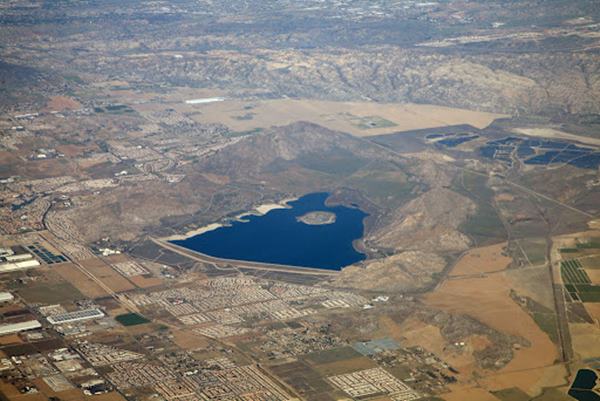
To fully appreciate the vastness and layout of Lake Perris, it’s essential to have a detailed understanding of its lake map. The lake covers an area of approximately 2,250 acres, providing ample space for fishing, boating, and other water activities. The lake map showcases various fishing spots, boat ramps, picnic areas, and campgrounds, allowing visitors to navigate the lake with ease.
Perris Lake Amenities
Lake Perris offers a wide range of amenities to ensure visitors have a comfortable and enjoyable fishing experience. Some of the key amenities include:
- Boat Rental: Visitors have the option to rent boats, including motorized boats, kayaks, and paddleboards, to explore the lake and find the perfect fishing spot.
- Picnic Areas: Lake Perris provides well-maintained picnic areas equipped with tables, BBQ grills, and shaded spots. Anglers can take a break from fishing and enjoy a relaxing picnic amidst the serene surroundings.
- Campgrounds: For those who wish to extend their stay, Lake Perris offers various campgrounds with facilities such as showers, restrooms, and fire rings. Camping near the lake allows anglers to wake up to the calming sounds of nature and start their day with a fresh catch.
- Fishing Piers: The lake features multiple fishing piers that provide easy access to prime fishing locations. These piers are wheelchair-accessible, making fishing accessible to individuals with disabilities.
Directions to Lake Perris
Getting to Lake Perris is convenient, thanks to its central location in Southern California. Here are some directions to help you find your way:
- From Los Angeles: Take the I-10 E and CA-60 E to Moreno Beach Dr. in Moreno Valley. Continue on Moreno Beach Dr. and follow the signs to the lake entrance.
- From San Diego: Take the I-15 N and CA-91 W to Moreno Beach Dr. in Moreno Valley. Follow the signs to the lake entrance.
- From Riverside: Take CA-60 E to Moreno Beach Dr. in Moreno Valley. Continue on Moreno Beach Dr. and follow the signs to the lake entrance.
Perris Lake Hours & Fees
Before planning your fishing trip to Lake Perris, it’s important to be aware of the lake’s operating hours and fees. The lake is open daily from sunrise to sunset. The entrance fee for vehicles is $10 per day, and there is an additional fee for boat launching. It’s recommended to check the official website or contact the lake authorities for the most up-to-date information on hours and fees.
Important Lake Warnings
While Lake Perris offers a perfect fishing experience, it’s crucial to be aware of certain warnings to ensure your safety and the preservation of the environment. Here are some important lake warnings:
- Fishing Regulations: Familiarize yourself with the fishing regulations and obtain the necessary permits before fishing in Lake Perris. Adhering to these regulations helps protect the fish population and maintain the ecosystem’s balance.
- Water Safety: Always wear a life jacket while boating or engaging in water activities. Be cautious of sudden changes in weather conditions and avoid swimming in unauthorized areas.
- Wildlife Interaction: Lake Perris is home to a diverse range of wildlife, including birds, reptiles, and mammals. Respect their natural habitat and refrain from feeding or disturbing them.
Nearby Fishing Lakes
Lake Perris is not the only fishing hotspot in Southern California. Anglers can explore other nearby fishing lakes for a change of scenery and angling opportunities. Some of the popular nearby fishing lakes include:
- Lake Elsinore: Located just a short drive from Lake Perris, Lake Elsinore offers excellent fishing opportunities, particularly for bass, catfish, and carp.
- Diamond Valley Lake: Situated in Hemet, Diamond Valley Lake is known for its trophy-sized bass and offers a serene fishing experience amidst scenic surroundings.
- Lake Matthews: With its calm waters and abundant fish population, Lake Matthews is a favorite spot for anglers seeking bass, catfish, and crappie.
What type of fish can be found in Lake Perris?

Nestled in the heart of Southern California, Lake Perris is a popular destination for fishing enthusiasts. With its serene surroundings and abundant aquatic life, this reservoir offers an exciting experience for anglers of all levels.
Largemouth Bass
– Largemouth Bass (Micropterus salmoides) is a highly sought-after game fish known for its aggressive strikes and impressive size.
– They have a dark green coloration with a distinctive black lateral line and can grow up to 10 pounds or more.
– Largemouth Bass are typically found near submerged structures, such as rocks, fallen trees, and vegetation.
Spotted Bass
– Spotted Bass (Micropterus punctulatus) are similar in appearance to Largemouth Bass but have distinct dark spots along their lateral line.
– They are known for their strong fighting ability and can reach sizes of up to 4 pounds or more.
– Spotted Bass prefer rocky areas and are often found near submerged structures.
Rainbow Trout
– Rainbow Trout (Oncorhynchus mykiss) are prized for their beautiful colors, including a pink stripe along their sides. – They are commonly stocked in Lake Perris, providing anglers with an excellent opportunity for trout fishing. – Rainbow Trout prefer colder water temperatures and are often found near the lake’s deeper sections.
Bluegill
– Bluegill (Lepomis macrochirus) are small panfish that are abundant in Lake Perris.
– They have a vibrant blue and green coloration with a distinctive black ear flap.
– Bluegill prefers shallow water near submerged vegetation or structures.
Catfish
– Catfish species, including Channel Catfish and Flathead Catfish, can be found in Lake Perris.
– They have a scaleless body and prominent barbels around their mouth.
– Catfish are primarily bottom feeders and can grow to impressive sizes.
Perch
– Perch species, including Yellow Perch and Redear Sunfish, can be found in Lake Perris.
– They have a distinctive spiny dorsal fin and vibrant coloration.
– Perch are commonly found near submerged structures or in open water.
Bass Fishing at Lake Perris

Types of Bass at Lake Perris
Largemouth Bass
Largemouth bass are the most sought-after species at Lake Perris. Known for their aggressive nature and impressive size, catching a largemouth bass can be a thrilling experience. These bass are predominantly found in the deeper parts of the lake, near submerged structures and vegetation. Largemouth bass at Lake Perris can grow up to 10 pounds or more, providing anglers with a true challenge.
Spotted Bass
Spotted bass are another popular species found in Lake Perris. While they may not grow as large as largemouth bass, they make up for it with their tenacity and fighting spirit. Spotted bass are often found near rocky areas and submerged structures. Anglers who prefer a more challenging and aggressive fishing experience will enjoy targeting this feisty bass.
Best Techniques for Bass Fishing
1. Use the Right Gear
To increase your chances of success, it is important to use the right gear when bass fishing at Lake Perris. Here are some essential items to include in your tackle box:
- Fishing rods: Medium to heavy action rods are ideal for bass fishing. A 7-foot rod with a fast tip is recommended for better sensitivity and control.
- Fishing reels: Baitcasting reels are popular among bass anglers due to their accuracy and casting distance.
- Fishing line: Use a high-quality monofilament or braided line with a test strength of 10-20 pounds.
- Lures: A variety of lures work well for bass fishing, including plastic worms, crankbaits, jigs, and spinnerbaits.
2. Master the Art of Casting
Casting is a crucial skill in bass fishing. Practice your casting technique to ensure accurate and precise casts. Aim for areas with submerged structures, vegetation, or rocky points, as these are prime hiding spots for bass.
3. Experiment with Different Retrieval Techniques
Bass can be finicky, so it’s important to experiment with different retrieval techniques to entice them to strike. Try a slow and steady retrieve, a stop-and-go retrieve, or even a twitching motion to mimic injured prey. Pay attention to the behavior of the bass and adjust your retrieval technique accordingly.
4. Target Early Morning and Late Evening
Bass are more active during low light conditions, so the early morning and late evening are prime times for bass fishing. Plan your fishing trips accordingly to maximize your chances of success.
Top Spots for Bass Fishing at Lake Perris
1. Bernasconi Beach
Bernasconi Beach is a popular spot for bass fishing at Lake Perris. The beach offers easy access to the water, making it ideal for anglers of all skill levels. Look for submerged structures and drop-offs near the beach for the best chances of catching bass.
2. Moreno Beach
Moreno Beach is another hotspot for bass fishing. The area is known for its rocky points and underwater structures, which attract bass. Cast your line near these areas and be prepared for an exciting battle with a largemouth or spotted bass.
3. The Dam
Fishing near the dam at Lake Perris can yield great results. The deeper waters and rocky structures provide a perfect habitat for bass. Use your fishfinder to locate schools of bass and target those areas for a productive fishing session.
Trout Fishing at Lake Perris

Types of Trout at Lake Perris
Rainbow Trout
Rainbow trout are the most common species found in Lake Perris. Known for their vibrant colors and acrobatic jumps, they provide an exhilarating fishing experience. They are typically stocked regularly by the California Department of Fish and Wildlife, ensuring a healthy population for anglers to target.
Brown Trout
Brown trout can also be found in Lake Perris, although they are less abundant compared to rainbow trout. These elusive fish are known for their wariness and can put up a good fight when hooked. They prefer cooler water temperatures and are often found near the deeper sections of the lake.
Best Techniques for Trout Fishing
1. Bait Fishing
Using bait is a popular technique for trout fishing at Lake Perris. The following baits are effective for attracting trout:
- PowerBait: Rainbow and garlic-flavored PowerBait are top choices for trout fishing at Lake Perris. Mold the bait onto a small hook and cast it out near areas where trout are likely to be feeding.
- Nightcrawlers: Live or dead nightcrawlers can entice both rainbow and brown trout. Thread the worm onto a hook and let it sink to the desired depth.
2. Lure Fishing
Lure fishing is another productive technique for catching trout at Lake Perris. The following lures are recommended:
- Spinners: Spinners such as Mepps or Rooster Tails in bright colors can mimic small fish or insects and attract trout. Retrieve the spinner at a steady pace, varying the speed to entice strikes.
- Jigs: Jigs in earthy tones or natural patterns can be effective for trout fishing. Cast the jig and let it sink before using a slow retrieve with occasional twitches to imitate a wounded baitfish.
Top Spots for Trout Fishing at Lake Perris
1. Sail Cove
Sail Cove is a popular spot for trout fishing at Lake Perris. It offers a sheltered area with plenty of underwater structure, attracting schools of trout. Fish near submerged rocks and fallen trees for the best chance of a catch.
2. Moreno Beach
Moreno Beach is another hotspot for trout fishing. The shallow waters near the beach provide an ideal feeding ground for trout. Cast your line near the drop-offs and submerged vegetation to increase your chances of success.
3. Bernasconi Beach
Bernasconi Beach is known for its clear water and rocky shoreline, making it an excellent spot for trout fishing. Look for areas with rocky outcrops and steep drop-offs, as trout often congregate in these locations.
Lake Perris Catfish Fishing
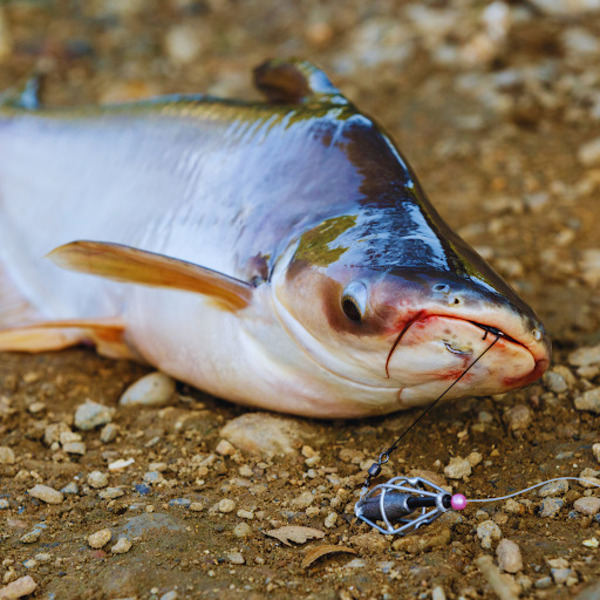
Types of Catfish at Lake Perris
Channel Catfish
The Channel Catfish is the most abundant catfish species found in Lake Perris. It is known for its slender body and deeply forked tail. Channel Catfish can grow to impressive sizes, with some specimens reaching over 40 pounds. These catfish are opportunistic feeders and are known to be attracted to a variety of baits, including chicken liver, nightcrawlers, and stinkbaits.
Blue Catfish
Blue Catfish, also referred to as “blues,” are another popular species found in Lake Perris. These catfish are recognized by their bluish-gray coloration and long, straight-edged anal fin. Blue Catfish can grow to remarkable sizes, with some individuals weighing over 100 pounds. They are known for their voracious appetites and tend to prefer live bait such as shad, sunfish, and other small fish.
Flathead Catfish
Flathead Catfish, also known as “yellow cats” or “Opelousas catfish,” are the largest species of catfish found in Lake Perris. They have a broad, flattened head and a mottled brown or yellowish-brown coloration. Flatheads are known for their bottom-dwelling behavior and are often caught using live bait such as sunfish, bluegill, or crawfish. These catfish can grow to immense sizes, with some exceeding 100 pounds.
Best Techniques for Catfish Fishing
Bottom Fishing
Bottom fishing is one of the most effective techniques for catfish fishing at Lake Perris. This technique involves casting your bait onto the lake’s bottom and waiting for the catfish to take the bait. Use a heavy sinker to ensure your bait stays on the bottom, as catfish are known to be bottom feeders. Chicken liver, nightcrawlers, and cut bait are popular choices for bottom fishing.
Jug Fishing
Jug fishing is a unique and exciting technique to catch catfish at Lake Perris. It involves using floating jugs or buoys to suspend your bait in the water. Simply attach your bait, such as live minnows or cut bait, to the jug and let it drift in the current. When a catfish takes the bait, the jug will start moving, indicating a bite. This technique allows you to cover a larger area and increases your chances of hooking a catfish.
Trotlining
Trotlining is a traditional method used to catch catfish in Lake Perris. It involves setting up a long line with multiple hooks across the water surface. The line is anchored on both ends and left in the water for a few hours. Trotlines can be baited with a variety of baits such as shad, crawfish, or cut bait. This technique is effective for targeting larger catfish species such as blues and flatheads.
Top Spots for Catfish Fishing at Lake Perris
Moreno Beach
Moreno Beach is a popular spot for catfish fishing at Lake Perris. Anglers can fish from the shoreline or utilize the fishing dock located in the area. The shallow waters near Moreno Beach are known to attract catfish, especially during the warmer months. Bottom fishing and jug fishing are productive techniques to try at this location.
Perris Beach
Perris Beach offers ample opportunities for catfish fishing. The beach area provides easy access to the lake, and the nearby underwater structures create ideal hiding spots for catfish. Try bottom fishing near submerged rocks or fallen trees to increase your chances of a successful catch.
Bernasconi Beach
Bernasconi Beach is a favored spot among catfish anglers. The beach’s proximity to deeper water makes it an excellent location for targeting larger catfish species. Trotlining is a popular technique used by anglers at Bernasconi Beach, as it allows them to cover a wide area and increase their chances of hooking a trophy-sized catfish.
Carp Fishing at Lake Perris

Types of Carp at Lake Perris
Lake Perris is home to various species of carp, each with its own unique characteristics. Understanding the different types of carp will help you tailor your fishing approach to increase your chances of success. Here are some of the common carp species found in Lake Perris:
1. Common Carp (Cyprinus carpio)
The common carp is the most prevalent species in Lake Perris. They are known for their adaptability and can be found in a variety of habitats, including shallow areas, deep waters, and near vegetation. Common carp have a large size range, with individuals weighing up to 40 pounds or more.
Read more: Reelfoot Lake Fishing: A Hidden Gem for Anglers | Everything You Need to Know
2. Mirror Carp (Cyprinus carpio)
Mirror carp, also known as leather carp, are another popular species found in Lake Perris. They are easily recognizable by their distinctive scales, which have a patchy or irregular pattern. Mirror carp can grow to impressive sizes, making them an exciting target for anglers.
3. Grass Carp (Ctenopharyngodon idella)
Grass carp are herbivorous fish that feed on aquatic vegetation. They are often introduced to lakes and ponds as a biological control method for excessive plant growth. Grass carp can reach a considerable size and provide an exciting challenge for anglers.
Best Techniques for Carp Fishing
To maximize your chances of success, it is essential to employ effective techniques when carp fishing at Lake Perris. Here are some tried-and-tested methods to help you reel in that trophy carp:
1. Bait Selection
Choosing the right bait is crucial when targeting carp. They are known to have a varied diet and can be enticed by a wide range of offerings. Some popular baits for carp fishing at Lake Perris include:
- Sweetcorn
- Boilies
- Bread
- Pellets
- Worms
Experiment with different baits to see which ones attract the carp in the lake.
2. Rig Setup
A well-designed rig setup is vital for carp fishing success. Consider using the following techniques:
- Hair rig: This setup allows the bait to be presented separately from the hook, increasing the chances of the carp taking the bait without feeling the resistance from the hook.
- Zig rig: A zig rig involves suspending the bait at different depths in the water column to target carp at different levels.
- Method feeder: Using a method feeder can be effective for attracting carp by creating a scent trail and presenting the bait in a concentrated area.
3. Location
Finding the right spot is crucial for successful carp fishing. Consider the following factors when choosing your fishing location:
- Vegetation: Carp are often found near submerged vegetation, as it provides them with food and shelter.
- Drop-offs: Look for areas with sudden depth changes, such as drop-offs or ledges, as carp may congregate there.
- Structure: Carp are known to seek out underwater structures, such as submerged trees or rock formations, as they provide hiding places and ambush points.
4. Patience and Stealth
Carp can be wary and easily spooked, so it’s important to practice patience and approach your fishing spot quietly. Avoid loud noises, and excessive movement, and use stealthy casting techniques to avoid scaring away the fish.
Top Spots for Carp Fishing at Lake Perris
Lake Perris offers several prime spots for carp fishing. Here are some of the top locations to try your luck:
1. Sail Cove
Sail Cove is a popular spot for carp fishing at Lake Perris. The cove offers a sheltered area with plenty of submerged vegetation, making it an ideal habitat for carp. It is recommended to fish close to the vegetation edges or around the sailboats for the best chance of success.
2. Bernasconi Beach
Bernasconi Beach is another hotspot for carp fishing. The area features a gradual slope and a sandy bottom, providing an excellent feeding ground for carp. Try fishing near the shoreline or close to any visible structures, such as fallen trees or rocks.
3. Romero Launch Ramp
Romero Launch Ramp is known for its deep water and abundance of carp. This spot is perfect for targeting larger carp, as they tend to inhabit the deeper areas of the lake. Use a method feeder setup to attract carp to your bait in this location.
Lake Perris Crappie Fishing
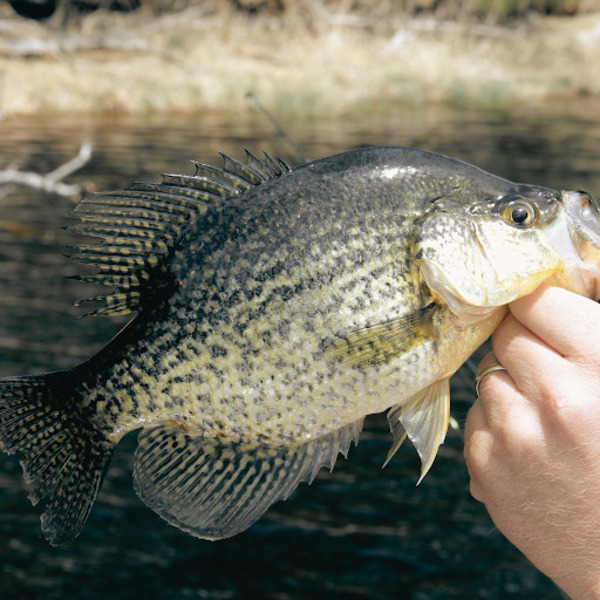
Types of Crappie at Lake Perris
Black Crappie
The first type of crappie you can find in Lake Perris is the black crappie (Pomoxis nigromaculatus). These fish are known for their dark coloration, with speckled patterns across their bodies. Black crappie tends to inhabit areas with submerged vegetation and woody cover, making them a bit trickier to locate. However, their aggressive feeding habits make them an exciting target for anglers.
White Crappie
The second type of crappie you may encounter at Lake Perris is the white crappie (Pomoxis annularis). Unlike their black counterparts, white crappie have lighter coloration with vertical bars along their bodies. They are often found in clearer water and prefer areas with structure, such as submerged trees and brush piles. White crappie are known for their schooling behavior, so if you find one, there’s a good chance you’ll find more nearby.
Best Techniques for Crappie Fishing
1. Light Tackle and Gear
Using light tackle and gear is crucial when targeting crappie at Lake Perris. Opt for a sensitive rod with a light or ultralight action paired with a small spinning reel. This setup allows you to feel even the slightest nibble and make accurate casts to your desired location.
2. Live Bait
Crappies are notorious for their preference for live bait. Minnows and small shads are highly effective in enticing these fish to bite. Hook your live bait through the lips or behind the dorsal fin and let it swim freely in the water. This mimics the natural movement of prey and increases your chances of attracting crappie.
3. Jigging
Jigging is a popular technique used by anglers to target crappie. Choose a small jig head (1/16 to 1/32 ounces) and pair it with a soft plastic grub or tube bait. Cast your jig near structures such as submerged trees, brush piles, or drop-offs, and use a slow, twitching retrieve to imitate injured baitfish. Crappies are often lurking around these areas, waiting for an easy meal.
4. Vertical Fishing
Vertical fishing is another effective technique for crappie fishing at Lake Perris. This method involves dropping your bait straight down into the water column, targeting specific depths where crappie are known to congregate. Use a slip bobber or a fishfinder rig to determine the depth at which crappie are suspended and adjust your presentation accordingly.
Top Spots for Crappie Fishing at Lake Perris
1. Moreno Beach
Moreno Beach is a popular spot for crappie fishing at Lake Perris. The area around the beach is known for its submerged vegetation, which attracts both black and white crappie. Target the edges of weed beds or cast near fallen trees for the best chance of success.
2. Bernasconi Beach
Bernasconi Beach is another hotspot for crappie fishing. The beach area features ample structure, including submerged trees and brush piles, where crappie likes to hide. Cast your bait near these structures and be prepared for some exciting action.
3. Sail Cove
Sail Cove is a secluded area of Lake Perris that provides excellent crappie fishing opportunities. The cove offers plenty of cover in the form of submerged vegetation, fallen trees, and rocky areas. Try casting your bait along the edges of these structures to entice crappie out of hiding.
4. Rock Climber’s Cove
Rock Climber’s Cove is a hidden gem for crappie fishing enthusiasts. This area is known for its rocky shoreline and submerged boulders, creating an ideal habitat for crappie. Consider using vertical fishing techniques near these rocky formations to target crappie at different depths.
Bluegill and Other Sunfish Fishing at Lake Perris
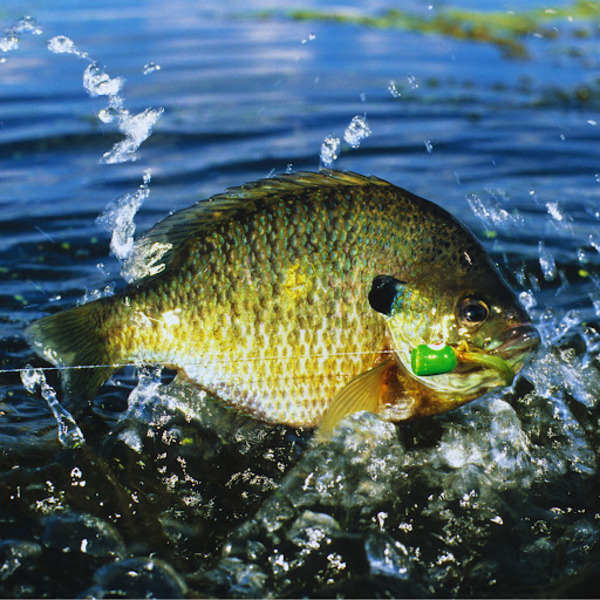
Types of Bluegill and Other Sunfish at Lake Perris
Bluegill
Bluegill, scientifically known as Lepomis macrochirus, is a popular sunfish species that can be found in Lake Perris. Known for its vibrant blue-green coloration and distinctive black opercular flap, bluegill is highly sought after by anglers due to its aggressive nature and delicious flavor. They typically range in size from 4 to 12 inches and can weigh up to 4 pounds.
Redear Sunfish
Redear sunfish, also known as shell crackers or stump knockers, is another sunfish species abundant in Lake Perris. They are easily distinguishable by the red or orange coloration on their gill covers. Redear sunfish are known for their larger size compared to bluegill, with some specimens reaching up to 15 inches in length. They are a popular target for anglers seeking a rewarding fishing experience.
Other Sunfish Species
In addition to bluegill and redear sunfish, Lake Perris is home to various other sunfish species. These include pumpkinseed sunfish, warmouth sunfish, and longear sunfish. Each species offers a unique angling challenge and adds to the overall diversity of fishing opportunities at Lake Perris.
Best Techniques for Bluegill and Other Sunfish Fishing
1. Bait Selection
– Use live bait such as worms, crickets, or grasshoppers to attract bluegill and other sunfish.
– Artificial baits like small jigs, soft plastics, or spinners can also be effective in enticing these fish.
2. Light Tackle
– Opt for light tackle setups, including ultralight spinning rods or fly fishing gear, to enhance the angling experience.
– Lighter gear allows for better control and sensitivity, making it easier to detect the subtle bites of bluegill and other sunfish.
3. Fishing Near Structure
– Bluegill and other sunfish are often found near submerged structures such as fallen trees, weed beds, or rocky areas.
– Target these areas by casting your bait close to the structure, as the fish will seek shelter and food in these locations.
4. Slow Presentation
– Present your bait or lure in a slow and natural manner to mimic the movements of small insects or prey that bluegill and other sunfish feed on.
– Avoid abrupt movements or fast retrieves, as these may deter the fish from biting.
Top Spots for Bluegill and Other Sunfish Fishing at Lake Perris
1. Sail Cove
– Sail Cove is known for its abundance of bluegill and other sunfish.
– Fish near the shoreline using light tackle and small baits to increase your chances of success.
2. Moreno Beach Area
– The Moreno Beach area is a hotspot for bluegill and redear sunfish.
– Look for structures such as submerged trees or brush piles to find these fish.
3. Bernasconi Beach Area
– Bernasconi Beach is another prime location for bluegill and other sunfish.
– Focus on the rocky areas and weed beds for the best results.
4. Lot 11 Area
– Lot 11 offers excellent opportunities for bluegill and redear sunfish fishing.
– Explore the shallower areas and use light tackle with live bait or small jigs.
The Best Places to Fish at Perris Lake, CA
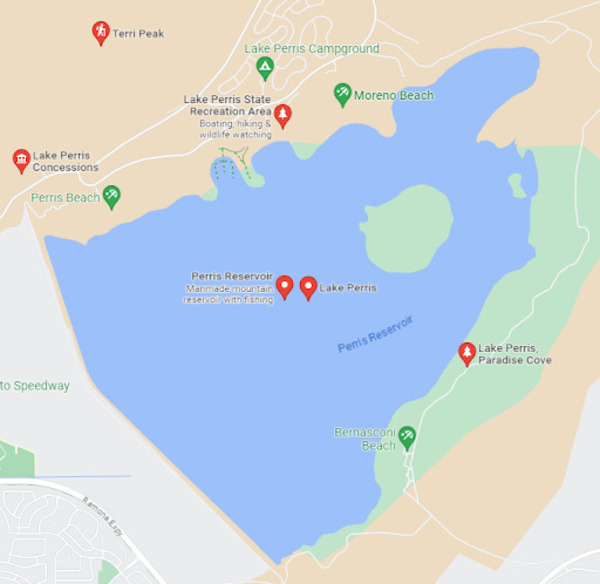
The Dam
Overview
The Dam at Perris Lake is a prime fishing spot, known for its abundant fish population and picturesque views. It offers a variety of fishing opportunities, including shore fishing, boat fishing, and kayak fishing. Anglers can expect to catch a variety of fish species, including largemouth bass, catfish, bluegill, and crappie.
Fishing Techniques
To maximize your chances of a successful catch at The Dam, consider using the following fishing techniques:
- Bass Fishing: Use plastic worms, crankbaits, or spinnerbaits to target largemouth bass. Cast your line near submerged structures or areas with vegetation for the best results.
- Catfish Fishing: Employ bottom fishing techniques with stink baits, chicken liver, or nightcrawlers to attract catfish. Set up your fishing rig near the shoreline or deeper areas.
- Panfish Fishing: Target bluegill and crappie using small jigs or live bait. Look for areas with shallow water or vegetation where these fish tend to gather.
Bernasconi Beach
Overview
Bernasconi Beach is a popular fishing spot at Perris Lake, known for its sandy shores and calm waters. It is an ideal location for families and anglers looking for a relaxing fishing experience. The beach is easily accessible, offering ample parking and picnic areas for a complete day of fishing and recreation.
Fishing Opportunities
At Bernasconi Beach, anglers can enjoy a variety of fishing opportunities, including:
- Shore Fishing: Cast your line from the beach and target species such as catfish, carp, bass, and bluegill. Use a variety of baits and lures to attract different fish species.
- Boat Fishing: Bring your boat or rent one from the nearby marina to explore the deeper waters of Perris Lake. This allows you to access different areas and increase your chances of catching larger fish.
Moreno Beach
Overview
Moreno Beach is another fantastic fishing spot at Perris Lake, offering a tranquil environment and stunning views. This location is known for its secluded areas, perfect for anglers seeking a peaceful fishing experience. Moreno Beach provides easy access to the lake, making it an excellent choice for shore fishing enthusiasts.
Fish Species
When fishing at Moreno Beach, anglers can expect to encounter a variety of fish species, including:
- Largemouth Bass: Target largemouth bass using topwater lures, plastic worms, or crankbaits. Look for areas with submerged structures or vegetation where these fish tend to hide.
- Catfish: Use stink baits, chicken liver, or nightcrawlers to attract catfish. Set up your fishing rig near the shoreline or deeper areas for optimal results.
Alessandro Island
Overview
Alessandro Island is a hidden gem for anglers looking for a unique fishing experience at Perris Lake. This small island offers a secluded and peaceful environment, making it an ideal spot for fishing enthusiasts seeking solitude. It is accessible by boat, kayak, or canoe, providing anglers with an opportunity to explore and fish in remote areas of the lake.
Fishing Tips
When fishing at Alessandro Island, keep the following tips in mind:
- Explore the Surroundings: Take advantage of the island’s remote location to explore different areas of the lake. Look for areas with submerged structures, fallen trees, or vegetation to find fish hiding spots.
- Use Stealth Approach: As the island is secluded, fish may be more easily spooked. Approach your fishing spot quietly and avoid excessive noise or disturbances.
What is the Best Time of Year to Fish at Lake Perris?
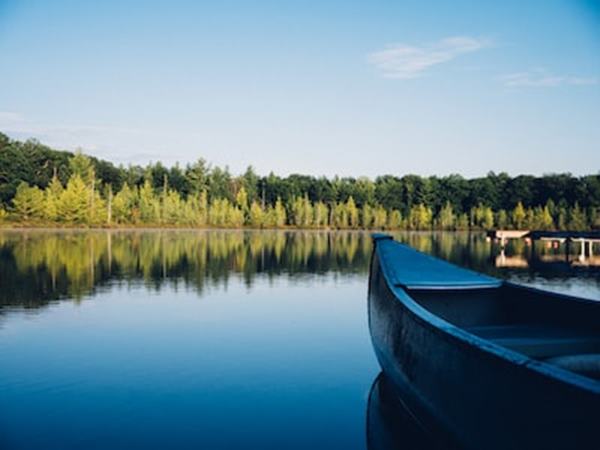
Spring Fishing (March – May)
The Arrival of Spring
As winter fades away, spring brings new life to Lake Perris. This season offers favorable fishing conditions and an abundance of fish species to target. Here are some highlights of spring fishing at Lake Perris:
- Active Fish
During spring, fish become more active as the water temperature increases. This increased activity makes them more willing to bite, providing an excellent opportunity for anglers.
- Spawning Season
Spring is also the spawning season for many fish species. This means that fish are actively moving to shallower areas to reproduce, making them more accessible to anglers.
- Popular Fish Species
Some of the popular fish species to target during spring fishing at Lake Perris include largemouth bass, rainbow trout, bluegill, and crappie.
Summer Fishing (June – August)
The Heat of Summer
As the temperature rises, so does the excitement for summer fishing at Lake Perris. While the scorching heat might deter some anglers, the rewards can be great for those who endure. Here’s what you can expect during summer fishing:
- Early Morning and Late Evening Success
During the summer, the best fishing opportunities are often during the early morning and late evening when the water is cooler. This is when fish are more active and likely to bite.
- Topwater Action
With the warm water temperatures, fish tend to move closer to the surface, providing excellent topwater action. Using lures such as buzzbaits or poppers can be highly effective during this time of year.
- Targeting Catfish
Summer is an ideal time for catfish fishing at Lake Perris. These bottom-dwelling fish are more active during the warmer months and can be caught using a variety of baits, including stinkbaits and chicken liver.
Fall Fishing (September – November)
The Changing Colors of Fall
Fall brings a vibrant display of colors to Lake Perris, and it also signals a shift in fishing patterns. As the water starts to cool down, different fish species become more active. Here’s what you need to know about fall fishing:
- Transition Period
Fall is a transition period for many fish species at Lake Perris. They begin to move from their summer locations to shallower areas in preparation for winter. This creates an excellent opportunity for anglers to target these moving fish.
- Bass Feeding Frenzy
Largemouth bass, in particular, go through a feeding frenzy during the fall months. They start to bulk up in preparation for the winter, making them more likely to bite.
- Trout Stocking
Rainbow trout stocking typically begins in the fall at Lake Perris. These stocked trout provide exciting fishing opportunities for anglers, especially in the areas where they are released.
Winter Fishing (December – February)
The Serenity of Winter
Winter fishing at Lake Perris may not be as popular as other seasons, but it offers a unique and tranquil experience for anglers seeking solitude. Here’s what you can expect during winter fishing:
- Cooler Water Temperatures
As the water temperature drops, fish activity slows down. However, certain fish species like trout and catfish remain active and can be targeted with the right techniques.
- Deep Water Fishing
During winter, fish tend to move to deeper areas where the water is warmer. Targeting these deeper spots can increase your chances of catching fish.
- Peaceful Environment
With fewer anglers on the water, winter fishing at Lake Perris provides a peaceful and serene atmosphere. It’s an excellent time to enjoy the beauty of the lake and connect with nature.
Lake Perris Fishing Tips & General Strategies
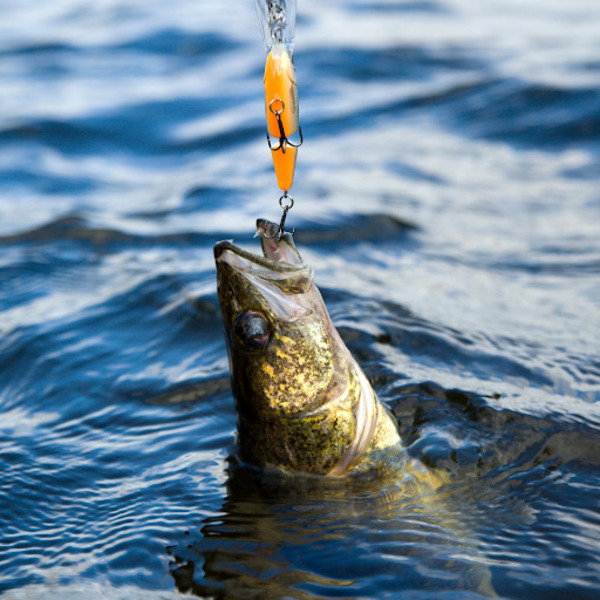
Water Clarity: Understanding the Conditions
1. Pay Attention to Water Clarity
Water clarity plays a crucial role in determining the success of your fishing expedition at Lake Perris. Understanding the different water clarity conditions will help you choose the appropriate fishing techniques and lures. Here are a few key points to consider:
- Clear Water
– In clear water conditions, fish tend to be more cautious and easily spooked.
– Use natural-colored lures that closely resemble the baitfish.
– Opt for finesse techniques such as drop shooting and wacky rigging.
- Stained Water
– In stained water conditions, fish are less wary and more likely to strike aggressively.
– Use lures that create vibration and noise, such as crankbaits and spinnerbaits.
– Experiment with brighter colors to increase visibility.
- Muddy Water
– In muddy water conditions, fish rely heavily on their sense of vibration and smell.
– Use lures with strong scents or rattles to attract their attention.
– Opt for larger lures that create more vibration.
2. Adjust Your Fishing Techniques
Based on the water clarity conditions, you may need to adapt your fishing techniques. Here are a few general strategies to consider:
- Slow Down Your Retrieve
– In clear water, fish can easily inspect your lure. Slow down your retrieve to make your presentation more natural and enticing.
- Increase Your Retrieve Speed
– In stained or muddy water, fish rely more on their sense of vibration. Increase your retrieve speed to create more disturbance and attract their attention.
- Experiment with Different Lure Colors
– Different water clarity conditions require different lure colors. Experiment with contrasting and brighter colors to increase visibility in stained or muddy water.
Structures & Cover: Finding the Hotspots
1. Identify Key Structures
Lake Perris is known for its abundant structures and cover, which provide shelter and feeding opportunities for fish. Identifying these key structures is essential for a successful fishing trip. Here are a few examples:
- Rock Piles
– Rock piles are a favorite hiding spot for fish, providing both cover and structure.
– Target areas with submerged rocks and try fishing around them using jigs or Texas-rigged soft plastics.
- Submerged Vegetation
– Submerged vegetation, such as lily pads and grass beds, attracts fish by providing cover and acting as a food source.
– Experiment with topwater lures, such as frogs or buzz baits, to entice fish hiding in the vegetation.
- Drop-offs and Points
– Drop-offs and points are natural fish highways, where fish congregate and transition between different depths.
– Use crankbaits or jigs to target these areas and entice fish holding near the structure.
2. Fish the Docks
The numerous docks at Lake Perris offer excellent fishing opportunities. Here are a few tips for dock fishing:
- Target Shaded Areas
– Fish are attracted to shaded areas provided by the docks, especially during hot summer months.
– Cast your lures or baits near the shaded areas to entice fish hiding under the docks.
- Use Skipping Techniques
– Skipping lures under the docks can be an effective way to reach areas that are difficult to access.
– Practice your skipping techniques to improve your accuracy and maximize your chances of success.
Fly Fishing at Lake Perris: A Paradise for Bluegill and Redear Sunfish Enthusiasts
Why Choose Fly Fishing for Bluegill and Redear Sunfish at Lake Perris?
1. Abundance of Bluegill and Redear Sunfish
Both bluegill and redear sunfish are plentiful in Lake Perris, making it an ideal destination for fly fishing enthusiasts. These species thrive in the lake’s clean and nutrient-rich waters, providing anglers with ample opportunities to catch them.
2. Beautiful Surroundings
Lake Perris is nestled amidst the picturesque Moreno Valley and offers stunning views of the surrounding San Jacinto Mountains. The tranquil ambiance and scenic beauty of the lake provide a serene backdrop for your fly-fishing adventures.
Read more: Irvine Lake Fishing – Full Guide of Fish Spice, Tips, Spots
3. Accessibility
Lake Perris is conveniently located near major cities, making it easily accessible for both local and visiting anglers. With its proximity to urban areas, you can enjoy a quick escape into nature without having to travel for hours.
Best Techniques for Fly Fishing Bluegill and Redear Sunfish at Lake Perris
1. Equipment
When fly fishing for bluegill and redear sunfish at Lake Perris, it is essential to have the right gear. Here’s what you’ll need:
- A lightweight fly rod (3-5 weight) for delicate presentations.
- Floating fly line to effectively cast and retrieve your flies.
- A variety of small to medium-sized nymphs, wet flies, and dry flies, imitate the insects these fish feed on.
2. Fly Selection
Choosing the right fly patterns is crucial to attract bluegill and redear sunfish. Some popular fly patterns for these species include:
- Bluegill: Foam spiders, woolly buggers, and small poppers.
- Redear Sunfish: Small crayfish patterns, damselfly nymphs, and beadhead nymphs.
3. Presentation
Mastering the art of presentation is key to fooling bluegill and redear sunfish into biting your fly. Here are some tips:
- Cast your fly near structures such as submerged rocks, fallen trees, and aquatic vegetation, where these species seek shelter and forage.
- Use a slow and subtle retrieve, imitating the natural movements of insects or small prey.
Top Fly Fishing Spots at Lake Perris
1. Moreno Beach
Moreno Beach is a popular spot for fly fishing at Lake Perris. The area offers convenient access and ample opportunities to catch bluegill and redear sunfish near the shoreline.
2. Bernasconi Beach
Bernasconi Beach is another prime location for fly fishing enthusiasts. The beach offers easy access to the water, and its shallow areas are ideal for targeting bluegill and redear sunfish.
3. Sail Cove
Sail Cove is a picturesque cove located on the eastern side of the lake. This secluded spot provides an excellent opportunity to fish for bluegill and redear sunfish while enjoying the tranquility of nature.
Highly Recommended Bait, Tackle & Gear: Enhancing Your Fishing Experience

Highly Recommended Bait, Tackle & Gear for Bass
Choosing the Right Bait
When it comes to bass fishing, selecting the right bait is essential. Here are some highly recommended options for bass:
- Plastic Worms
– Plastic worms are a versatile and effective choice for bass fishing. – Opt for different colors and sizes to match the conditions and preferences of the fish. – Rig them with a Texas or Carolina rig for optimal results.
- Crankbaits
– Crankbaits are excellent for covering a large area and attracting bass. – Choose different depths and colors based on the water conditions and the depth at which the fish are feeding. – Experiment with different retrieval speeds to find the most effective technique.
- Spinnerbaits
– Spinnerbaits are known for their ability to mimic baitfish and trigger aggressive strikes from bass. – Vary the blade size, color, and skirt to match the conditions and the bass’s feeding habits. – Retrieve the spinner bait at different speeds to determine what works best.
Essential Tackle & Gear
To optimize your bass fishing experience, having the right tackle and gear is crucial. Here are some highly recommended options:
- Fishing Rod and Reel
– Choose a medium to medium-heavy rod with a fast action for bass fishing. – Pair it with a baitcasting or spinning reel, depending on your preference and skill level. – Ensure that the reel has a smooth drag system and a high line capacity.
- Fishing Line
– Opt for a braided or fluorocarbon fishing line for bass fishing. – Braided lines provide excellent strength and sensitivity, while fluorocarbon lines offer invisibility in the water. – Select the line strength based on the size of the bass you expect to catch and the cover you’ll be fishing.
- Terminal Tackle
– Use high-quality hooks, such as offset worm hooks or EWG (Extra Wide Gap) hooks, for rigging plastic worms. – Employ a variety of weights, such as bullet weights or tungsten weights, to adjust the sinking rate of your bait. – Include swivels and snap clips for quick bait changes and to prevent line twists.
Highly Recommended Bait, Tackle & Gear for Rainbow Trout
Choosing the Right Bait
When targeting rainbow trout, it’s essential to select bait that appeals to their feeding habits. Here are some highly recommended options:
- PowerBait
– PowerBait is a popular choice for rainbow trout fishing. – Opt for colors such as chartreuse, pink, or rainbow, which are known to attract trout. – Mold the PowerBait onto small hooks or use it with a floating rig for optimal results.
- Small Spinners
– Small spinners, such as Mepps or Panther Martin, are effective lures for rainbow trout. – Choose sizes between 1/16 to 1/8 ounce and experiment with different colors to find what works best. – Retrieve the spinner at a slow to medium pace to imitate the movement of a small fish.
- Natural Baits
– Natural baits like worms, maggots, or salmon eggs can be highly effective for rainbow trout. – Rig them on a small hook and use split shots or a small float to adjust the depth. – Experiment with different presentations, such as a drifting or suspended approach.
Essential Tackle & Gear
To maximize your chances of catching rainbow trout, having the right tackle and gear is essential. Here are some highly recommended options:
- Fishing Rod and Reel
– Choose a light or ultralight spinning rod for rainbow trout fishing. – Pair it with a spinning reel that provides a smooth drag system and excellent line capacity. – Opt for a sensitive rod that allows you to detect subtle bites.
- Fishing Line
– Use a light monofilament or fluorocarbon line for rainbow trout fishing. – Light lines provide better sensitivity and allow your bait to move naturally in the water. – Select a line strength between 2 to 6 pounds, depending on the size of the trout you expect to catch.
- Terminal Tackle
– Use small hooks, such as size 8 to 14, for rainbow trout fishing. – Include split shots or small floats to adjust the depth and keep your bait in the strike zone. – Carry a variety of swivels and snap clips for quick and easy bait changes.
Highly Recommended Bait, Tackle & Gear for Bluegill & Sunfish
Choosing the Right Bait
When targeting bluegill and sunfish, selecting bait that appeals to their feeding habits is crucial. Here are some highly recommended options:
- Live Bait
– Bluegill and sunfish have a preference for live bait. – Use small worms, crickets, or grasshoppers as bait. – Present the bait on a small hook with or without a bobber, depending on the depth you’re fishing.
- Artificial Lures
– Small jigs, soft plastics, or flies can also be effective for bluegill and sunfish. – Choose colors and sizes that imitate insects or small baitfish. – Retrieve the lure with a slow and steady retrieve to entice these fish to strike.
- Natural Baits
– Natural baits such as bread, corn, or dough baits can be highly effective for bluegill and sunfish. – Mold the bait onto small hooks or use a small piece of bait on a small treble hook. – Adjust the depth by adding a small float or fishing without one, depending on the fish’s feeding behavior.
Essential Tackle & Gear
Having the right tackle and gear is essential for successful bluegill and sunfish fishing. Here are some highly recommended options:
- Fishing Rod and Reel
– Choose a light spinning rod for bluegill and sunfish fishing. – Pair it with a small spinning reel that offers a smooth drag system and good line capacity. – Opt for a sensitive rod that allows you to detect the subtle bites of these fish.
- Fishing Line
– Use a light monofilament or fluorocarbon line for bluegill and sunfish fishing. – Light lines provide better sensitivity and allow your bait to move naturally in the water. – Select a line strength between 2 to 6 pounds, depending on the size of the fish you expect to catch.
- Terminal Tackle
– Use small hooks, such as size 6 to 12, for bluegill and sunfish fishing. – Include split shots or small floats to adjust the depth and keep your bait in the strike zone. – Carry a variety of swivels and snap clips for quick and easy bait changes.
Highly Recommended Bait, Tackle & Gear for Catfish
Choosing the Right Bait for Catfish
- Live Bait
When it comes to catfish, live bait is often the most effective choice. Some popular live baits for catfish include:
- Nightcrawlers: These large worms are irresistible to catfish and can be easily found at bait shops or dug up from your backyard.
- Minnows: Small fish like shiners or fathead minnows are excellent choices for catfish bait.
- Bluegills: If you have access to a pond or lake with bluegills, using them as live bait is a surefire way to attract catfish.
- Cut Bait
Cut bait refers to pieces of fish that are used as bait. It is a popular choice for catfish anglers due to its strong scent and ability to attract larger catfish. Some commonly used cut baits include:
- Shad: Shad is a common baitfish that catfish find irresistible. Cut pieces of shad can be used as bait to entice catfish.
- Skipjack: Similar to shad, skipjack is another baitfish that catfish love. Cutting up skipjack into chunks is a great way to attract catfish.
- Prepared Bait
Prepared baits are commercially available options that come in various forms such as dough, dip baits, or stink baits. These baits are designed to release strong scents and flavors that attract catfish. Some popular prepared baits include:
- Blood bait: Blood-based baits are known for their strong scent and are highly effective in attracting catfish.
- Cheese bait: These baits are made with cheese and other ingredients that create a powerful odor that catfish find irresistible.
Essential Tackle & Gear for Catfish
- Fishing Rod
Choosing the right fishing rod for catfishing is crucial for a successful catch. Look for a rod that is sturdy, durable, and has a heavy or medium-heavy power rating. A longer rod, around 7 to 8 feet, will provide better casting distance and leverage when reeling in large catfish.
- Fishing Reel
Pair your fishing rod with a reel that can handle the weight and strength of catfish. A baitcasting reel with a high line capacity and a strong drag system is ideal for catfishing. Make sure the reel is built to withstand the powerful runs of catfish.
- Fishing Line
When it comes to catfishing, a strong and abrasion-resistant fishing line is essential. Monofilament or braided lines with a test strength of 20 to 30 pounds are recommended. These lines can handle the weight and fight of catfish without breaking.
- Hooks
Using the right hooks will greatly increase your chances of hooking and landing catfish. Opt for circle hooks, which are designed to hook the fish in the corner of the mouth, reducing the risk of deep hooking. Choose sizes between 2/0 and 6/0, depending on the size of the catfish you are targeting.
- Weights
Using the appropriate weight is crucial for getting your bait down to where the catfish are. Use sinkers or weights that are heavy enough to keep your bait near the bottom, where catfish usually feed.
- Landing Net
A landing net is essential for safely landing and handling catfish. Look for a net with a large hoop and a sturdy handle that can handle the weight of larger catfish.
- Tackle Box
Investing in a good tackle box will help you stay organized and keep your catfishing gear in top condition. Look for a tackle box with multiple compartments, sturdy construction, and a secure closure mechanism.
Marinas at Lake Perris

1. Marina A: Your Gateway to Adventure
Located on the northern shore of Lake Perris, Marina A is the main marina at Lake Perris State Recreation Area & Marina. It offers various amenities and services, making it the perfect starting point for your adventure on the lake. Here are some key features of Marina A:
- Boat Rentals: If you don’t have your own boat, don’t worry! Marina A offers boat rentals, allowing you to explore the lake at your own pace. Choose from a variety of options, including kayaks, canoes, and motorized boats.
- Boat Launching: Marina A provides a convenient boat launching area, making it easy for you to get your boat into the water. Whether you’re bringing your own watercraft or renting one, Marina A has you covered.
- Fuel Station: Need to fuel up before hitting the water? Marina A has a fuel station where you can fill up your boat’s tank and ensure a worry-free day on the lake.
2. Marina B: A Serene Escape
Located on the southern shore of Lake Perris, Marina B offers a quieter and more serene atmosphere compared to Marina A. Here’s what you can expect at Marina B:
- Mooring: Marina B provides mooring facilities for boat owners who wish to keep their watercraft at the lake. With easy access to the water, you can enjoy spontaneous trips on the lake whenever you desire.
- Fishing Opportunities: If you’re an avid angler, Marina B is the place to be. The marina is surrounded by prime fishing spots, where you can cast your line and reel in various fish species, including bass, catfish, and trout.
- Picnic Areas: Marina B features beautiful picnic areas where you can relax and enjoy a meal with your family or friends. Take in the scenic views while savoring a delicious picnic lunch.
Benefits of Visiting the Marinas at Lake Perris State Recreation Area & Marina
1. Abundance of Water Activities
Lake Perris State Recreation Area & Marina is a haven for water enthusiasts. Whether you enjoy boating, fishing, swimming, or simply relaxing by the water, the marinas offer endless opportunities for fun and adventure.
2. Spectacular Scenery
Surrounded by rolling hills and stunning landscapes, Lake Perris State Recreation Area & Marina provides a picturesque backdrop for your aquatic adventures. Immerse yourself in the beauty of nature and let the serene atmosphere wash away the stresses of everyday life.
3. Family-Friendly Environment
The marinas at Lake Perris State Recreation Area & Marina are perfect for families. With a range of activities catering to all ages, you can create lasting memories with your loved ones. From boating adventures to fishing competitions, there’s something for everyone to enjoy.
4. Well-Maintained Facilities
Both Marina A and Marina B are equipped with well-maintained facilities to ensure a comfortable and enjoyable experience for visitors. From clean restrooms to picnic areas, you’ll find everything you need for a day of fun at the lake.
What are the Fishing Regulations at Lake Perris?

1. Fishing Licenses
To fish at Lake Perris, anglers must possess a valid California fishing license issued by the CDFW. Licenses can be obtained online through the CDFW’s official website or through authorized vendors. It’s crucial to carry your fishing license with you while fishing at Lake Perris, as failure to do so may result in penalties.
2. Fish Species and Bag Limits
Lake Perris is home to various fish species, including largemouth bass, striped bass, catfish, bluegill, and crappie. Each species has specific regulations regarding size limits and bag limits. It is essential to familiarize yourself with these regulations to prevent unintended violations.
2.1 Largemouth Bass
– The minimum size limit for largemouth bass is 12 inches.
– The bag limit for largemouth bass is five fish per day.
2.2 Striped Bass
– The minimum size limit for striped bass is 18 inches.
– The bag limit for striped bass is two fish per day.
2.3 Catfish
– There are no size limits for catfish at Lake Perris.
– The bag limit for catfish is five fish per day.
2.4 Bluegill
– There are no size limits for bluegill at Lake Perris.
– The bag limit for bluegill is 25 fish per day.
2.5 Crappie
– The minimum size limit for crappie is 10 inches.
– The bag limit for crappie is 25 fish per day.
3. Fishing Methods and Gear
Anglers at Lake Perris have several options when it comes to fishing methods and gear. However, it’s crucial to adhere to the regulations set forth by the CDFW to protect the fish population and maintain a sustainable fishing environment.
3.1 Bait and Lures
– Anglers can use both live and artificial baits at Lake Perris.
– Examples of allowed baits include worms, crickets, minnows, and artificial lures.
3.2 Fishing Techniques
– Anglers can use various fishing techniques such as casting, trolling, and fly fishing.
– It is important to follow all applicable fishing regulations while employing these techniques.
3.3 Fishing Gear
– Anglers can use fishing rods and reels, as well as other permitted fishing gear.
– It is essential to use appropriate gear and ensure it is in compliance with the regulations.
Conclusion: Gear Up and Get Out Fishing on Lake Perris!
Lake Perris is a prime destination for fishing enthusiasts. Located in Riverside County, California, this fishing hot spot offers a variety of fish species and a beautiful natural setting. One of the most popular activities at Lake Perris is spotted bass fishing. The lake is regularly stocked with this type of bass, making it a great place for anglers to try their luck. Additionally, the lake is home to a wide array of fish, including catfish, crappie, bluegill, and rainbow trout. If you’re looking for a challenge, striper fishing is also available at Lake Perris. Anglers report catching some impressive specimens of this popular game fish.
One of the advantages of fishing at Lake Perris is the accessibility. Whether you prefer fishing from a boat or from the shoreline, there are plenty of options to choose from. The lake features multiple fishing piers and docks, as well as areas where you can cast your line from the shore. When fishing from a boat, be aware that there are some regulations in place. Boat operators are required to have a valid California Boater Card and follow all boating laws and safety regulations.
Before heading out to Lake Perris for a fishing trip, there are a few things you should keep in mind. Firstly, fishing permits must be purchased before you can cast your line into the water. These permits are available online or at designated vendors near the lake. Additionally, it’s important to be aware of any guidelines and restrictions that apply to the specific type of fishing you plan to do. For example, if you’re interested in striper fishing, there may be specific size and bag limits that apply.
So, gear up and get ready for a great fishing experience at Lake Perris. Whether you’re a seasoned angler or a beginner, there’s something for everyone here. With its diverse fish population and beautiful surroundings, Lake Perris is the perfect place to cast your line and relax in nature.
FAQs
Q: What is Lake Perris fishing?
A: Lake Perris fishing refers to fishing activities that take place in Lake Perris, a popular fishing destination in California.
Q: What are some popular terms related to Lake Perris fishing?
A: Some popular terms related to Lake Perris fishing include boat, lure, fishing report, best fishing, cove, ramp, Bernasconi, Alessandro Island, and East End.
Q: Are there boat ramps available at Lake Perris?
A: Yes, Lake Perris has boat ramps that allow anglers to launch their boats into the lake.
Q: Where is East End located in Lake Perris?
A: East End refers to a specific area located in Lake Perris.
Q: How can I catch fish at Lake Perris?
A: Lake Perris offers various fishing opportunities. Anglers can use different techniques and bait to catch fish.
Q: What is the best bait to use for Lake Perris fishing?
A: The best bait to use for Lake Perris fishing depends on the type of fish you are targeting. Different fish species may respond better to different types of bait.
Q: Can I find a fishing guide for Lake Perris?
A: Yes, there are fishing guides available for Lake Perris. They can provide assistance and guidance to anglers.
Q: Where can I get a fishing report for Lake Perris?
A: Fishing reports for Lake Perris can be obtained from various sources, including local fishing shops, online resources, and the Department of Fish and Game.
Q: What are the best spots for fishing at Lake Perris?
A: Lake Perris offers a wide variety of fishing spots. Some popular areas include the East End, Bernasconi, Alessandro Island, and marshy areas of the lake.
Q: Are there any restrictions or permits needed for fishing in Lake Perris?
A: Fishing in Lake Perris may require a valid fishing license, which can be purchased at the bait shop. Some specific restrictions and regulations may also apply, so it’s important to familiarize yourself with the rules before fishing.

